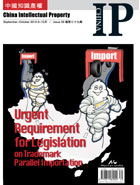Parallel importation has been regarded as an archaic topic in the areas of international trade and intellectual property (IP) rights. Despite years of theoretical debates and national legal practices, no consensus has yet been reached as to how to respond. Compared with the parallel importation of patents and copyrights, the issue of trademark parallel importation seems to stand out more prominently.
It is not difficult to find that it mainly involves several adversarial relationships; namely, the doctrines of exhaustion and of territoriality, rights owners and consumers, private and public interests, trade liberalization and IP protection. How to view the issue of parallel importation is, in fact, a question of how to coordinate the interests and conflicts of the foregoing adversarial relationships.
The legality of trademark parallel importation depends on the various stances and principles each country takes in this regard. At present, debates over parallel importation take place mostly in developed countries, mainly because of the higher levels of their economic development and their relative advantages in international trade.
China is a developing country with lower production costs and is ranked with the low-cost countries. In the past, there were few cases of parallel importation of IP products into China. With China’s entry into the WTO, as well as policy changes in other aspects, the phenomena of parallel importation has surfaced, but China’s existing laws do not have specific provisions on the issue of parallel importation.




